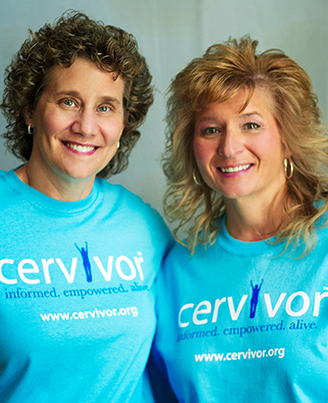Four cervical cancer stages
Cervical cancer is divided into four main stages. The stages help determine the best treatment.
Stage I: The cancer is only in the cervix or uterus.
Stage II: The cancer has spread past the cervix and the uterus.
Stage III: The cervical cancer has spread further – possibly into the lower vagina and the pelvic wall. It may be blocking tubes that carry urine from the kidneys to the bladder.
Stage IV: The cervical cancer has spread beyond the pelvis. It is metastatic, meaning it has spread to other parts of the body such as the bladder, rectum, bone, liver, or brain.
Stages are divided further into sub-stages with letters and numbers. For example, the sub-stages of Stage I cancer are IA1, IA2, IB1, and IB2.
There are also different types of cervical cancers. The two main types are squamous cell carcinoma, which is common, and adenocarcinoma. A small percentage of cancers are adenosquamous carcinomas and an even smaller percentage are small cell and large cell neuroendocrine carcinomas.
Treating cancer
Before deciding on the best treatment, you and your healthcare provider will need to discuss:
- The stage of the cancer.
- The size of the tumor.
- Your age.
- If you’re pregnant. For cervical cancer found in its early stages, or for cancer diagnosed during the last trimester of pregnancy, treatment may be delayed until after the baby is born.
- If you want to have children in the future.
Cervical cancer can be treated with surgery, radiation, or chemotherapy – or perhaps a combination of all three.
Surgery may be removal of the tumor, a hysterectomy, a radical hysterectomy, or a radical vaginal trachelectomy (RVT).
They type of surgery will depend on the stage of the cancer and if you want to become pregnant in the future.
- A hysterectomy involves removal of the uterus and cervix.
- A radical hysterectomy includes removal of the uterus and cervix, as well as the tissues next to the uterus, the upper part of the vagina, and sometimes the ovaries and fallopian tubes. Some pelvic lymph nodes may be removed as well.
- A radical vaginal trachelectomy (RVT) may be an option if you want to become pregnant in the future and your cancer is in an early stage. The surgeon removes the cervix, part of the vagina, and the pelvic lymph nodes while leaving the uterus in place.
Chemotherapy with radiation is generally used to treat stage II, stage III, and stage IV cervical cancer.
After chemotherapy and radiation are complete, your healthcare provider may also suggest a hysterectomy.
- Chemotherapy uses anti-cancer drugs that are either injected into a vein or taken by mouth.
- Radiation therapy uses high energy x-rays to kill cancer cells. These x-rays may be given externally or internally. External radiation is like having a diagnostic x-ray; internal radiation is given through a cylinder placed in the vagina.
What’s the best treatment?
We’re not qualified to answer that. But we can urge you to bring plenty of questions to your healthcare provider.
Here’s a start:
- How will you decide which procedure to use?
- What will the treatment cost?
- What are the side effects?
- How will this affect my sex life?
- How will this affect my fertility?
- Will I lose time off work?
- Do I have to stay overnight in the hospital?
- Does this cure me?
- How will I know if I’m cured?
If you are thinking about pregnancy in the future, you’ll also want to ask your healthcare provider questions such as these:
- Am I a candidate for RVT (radical vaginal trachelectomy)?
- Will I be able to keep my uterus?
- Will I be able to keep my ovaries?
- Can I harvest eggs before or after treatment?
- I don’t have a partner. Can I freeze unfertilized eggs?
- If I keep my ovaries and have radiation, will I be able to harvest eggs afterwards?
- Can my ovaries be moved up higher for protection from radiation?
- Can you recommend a reproductive endocrinologist?
If you feel you’re not getting the attention you deserve or answers to your questions, remember, you can choose someone else to provide your care. You’re in charge of your health – and you deserve someone to help you make choices.
What are the outcomes for cervical cancer treatment?
 Many factors affect a person’s outcome, including what stage you are diagnosed with, what your overall health is and how well your cancer responds to treatment. We also keep learning how important a person’s state of mind is to a cancer diagnosis.
Many factors affect a person’s outcome, including what stage you are diagnosed with, what your overall health is and how well your cancer responds to treatment. We also keep learning how important a person’s state of mind is to a cancer diagnosis.
Just to give you an idea of survival statistics, women who are diagnosed with stage IA cervical cancer have a five-year survival rate of 95%. Five-year survival rates look at people who were treated at least 5 years ago and refer to the percentage of women who lived at least 5 years after their cancer was diagnosed. Women diagnosed in later stages will see a lower 5-year survival rate – but remember, many women live a long, full life after a cancer diagnosis.